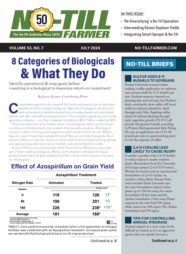According to USDA, 23% of Pennsylvania corn had been planted on May 6th, 2024, and few soybean acres have gone in so there is still a lot of planting that needs to be done. After a short dry spell most of the state received welcome precipitation and surface soil moisture conditions are pretty much on par with the average for the time of the year. On May 6, soil moisture in the top 4 inches was 35% in the southeastern station of Salunga-Landisville (average is 37%) and 39% in State College (average 41%) (Green Cast Soil Moisture Maps). Cloudy/rainy and sunny days will alternate according to the weather report so soil moisture will probably continue to be relatively high.
While this is great to get the crop going once the seed is in the ground, it may pose some challenges with sidewall compaction being a major threat. Sidewall compaction is caused by the double-disk openers that open the V-shaped slot in which the seeds are placed. If the surface soil contains significant amounts of clay, which is typical for Pennsylvania, and the soil is moist, the soil on both sides of the seed slot will look glazed and shiny – the soil is compacted around the seed. The problem is typically greater with corn than soybeans because corn gets planted deeper, requiring the double-disk openers to move more soil sideways, while the soil at 2" depth is typically more moist than that at 1" depth, compounding the problem. The risk of sidewall compaction can be judged by doing the 'ball test' – grab a handful of soil to the depth of planting, knead it in your hand, and if you can easily make a ball out of the soil the soil is in the 'plastic state' meaning it is easy to cause sidewall compaction. The danger of sidewall compaction is typically greater when the soil has already been compacted by field traffic (for example from manure, lime or fertilizer spreading, or herbicide applications). In that case, the tendency is to increase downpressure on the planting units, causing greater potential of sidewall compaction.
The roots that emerge from the corn seed, the seminal root system, are typically most affected by sidewall compaction. If the sidewalls are compacted, the seminal roots will not be able to branch out and you end up with a '2-D' root system that follows the seed slot only. The danger is greater when a dry period follows planting – even causing the seed slot to crack open. The sidewall now becomes very hard and difficult to penetrate to the young roots. You can judge the phenomenon by digging out some corn and turning the roots around – you will see that the roots are in one vertical plane only. The crown roots are typically less affected by sidewall compaction, causing corn to 'grow out' of the damage eventually. These roots develop from the crown base (starting with V-1) which is lifted to about ¾ to ½ inch deep below the soil surface due to elongation of the mesocotyl. Nonetheless, early growth is affected and may hurt yield potential and increase susceptibility to early pests and diseases. Some effects of sidewall compaction may include stunting of the young corn plants, susceptibility to drought, and phosphorus and potassium deficiencies.
Planting at the 'right' soil moisture content ranks as number one to reduce sidewall compaction. Another way of reducing it is to have a soil with excellent tilth – this can be achieved by using soil health principles to reduce soil disturbance, increase surface organic matter content, and using cover crops. Machinery tips to reduce sidewall compaction include: reducing down-pressure on gauge wheels and closing wheels; having good residue cover next to the row so the soil remains moist; using spoked closing wheels to fracture the sidewall, and using a depth gauge wheel that has a slightly smaller diameter next to the opening coulter to avoid packing the soil there.







Post a comment
Report Abusive Comment